Your living space profoundly impacts your daily life, from your mood and productivity to your overall wellbeing. Through strategic interior design choices, you'll create environments that nurture both body and mind. Smart color selection can energize or calm you, while proper lighting enhances your natural rhythms. You can maximize your space with multifunctional furniture and innovative storage solutions, all while maintaining sustainability through eco-friendly materials and practices. By incorporating biophilic elements and thoughtful technology integration, you'll transform your space into a personalized sanctuary. Discover how intentional design choices can revolutionize your lifestyle experience.
Key Takeaways
- Interior design influences psychological well-being through strategic use of colors, lighting, and spatial arrangements to create emotionally balanced environments.
- Multi-functional furniture and smart storage solutions maximize space efficiency while maintaining aesthetic appeal and daily functionality.
- Sustainable design practices incorporate eco-friendly materials and energy-efficient solutions to support both environmental consciousness and healthy living spaces.
- Personal expression through meaningful objects and color choices creates spaces that reflect individual identity and support emotional connection.
- Technology integration enhances lifestyle convenience while maintaining visual harmony through elegant, unobtrusive smart home solutions.
Psychology Behind Space Design
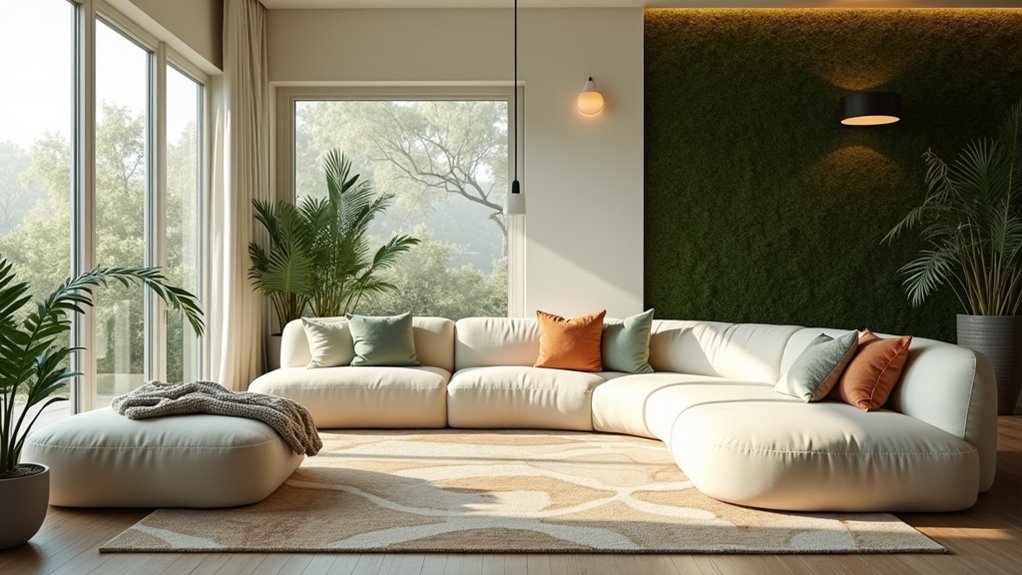
Have you ever wondered why certain rooms make you feel instantly relaxed while others create anxiety? The psychology behind space design explains how your environment directly impacts your mental state and behavior.
Colors, lighting, and spatial arrangement trigger specific emotional responses in your brain. You'll find that warm colors like red and orange energize you, while cool blues and greens promote calmness.
Natural light boosts your mood and productivity, while harsh fluorescent lighting can increase stress levels. The height of your ceilings affects how you think – higher ceilings encourage creative thinking, while lower ones help you focus on detail-oriented tasks.
Room layout matters too. Open spaces can reduce claustrophobia, while clearly defined zones help your brain organize activities and reduce mental clutter.
Color Theory in Daily Living
Why do certain colors consistently evoke specific emotional responses across cultures? The answer lies in both our evolutionary development and shared human experiences.
You'll find that warm colors like red and orange trigger alertness and energy, while cooler tones like blue and green promote calmness and tranquility.
You can harness this knowledge to transform your living spaces. Paint your bedroom in soothing lavender to aid sleep, or energize your home office with yellow accents.
Remember that color intensity matters too – saturated hues stimulate, while muted tones relax.
Consider using the 60-30-10 rule: choose a dominant color for 60% of your space, a secondary color for 30%, and an accent color for 10%. This balance creates visual harmony while maximizing the psychological benefits of your chosen palette.
Sustainable Design Practices
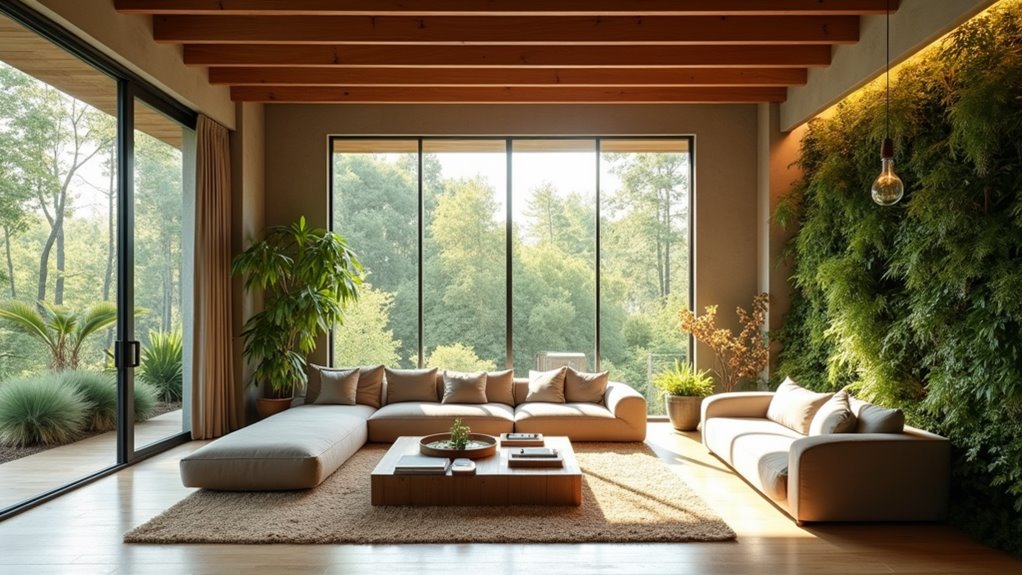
While traditional interior design often prioritizes aesthetics alone, sustainable design practices merge beauty with environmental responsibility.
You'll find that incorporating eco-friendly materials, energy-efficient lighting, and recycled furnishings doesn't mean sacrificing style.
You can start by choosing low-VOC paints, bamboo flooring, or reclaimed wood furniture. These choices reduce environmental impact while adding character to your space.
Consider installing LED lighting systems and maximizing natural light through strategic window treatments. You'll save energy and create a healthier living environment.
Don't forget about water conservation.
Installing low-flow faucets and using drought-resistant indoor plants helps minimize water waste.
Maximizing Small Living Spaces
Living in compact spaces doesn't mean sacrificing comfort or style. You can transform your small space into a functional, beautiful environment by implementing smart design strategies.
Start by choosing multi-purpose furniture, like ottoman storage units or fold-down tables, to maximize utility without cluttering your space.
Create the illusion of more room by using mirrors strategically, keeping color schemes light, and allowing natural light to flow freely. You'll want to think vertically – install floating shelves and utilize wall space for storage.
Consider furniture that's proportional to your space, avoiding bulky pieces that overwhelm the room.
Don't forget to establish distinct zones for different activities through clever furniture placement and room dividers.
Biophilic Design Elements
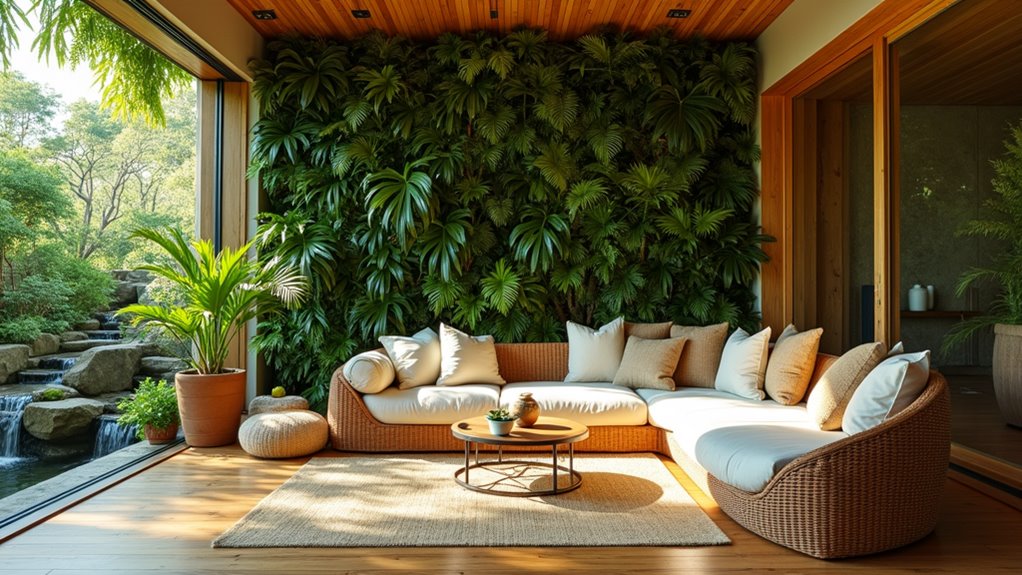
Nature's influence on interior design extends far beyond decorative houseplants. By incorporating biophilic elements, you'll create spaces that connect you with the natural world and enhance your overall well-being.
You can integrate organic materials like wood, stone, and bamboo into your furniture and surfaces, while maximizing natural light through strategic window treatments.
Consider adding water features that provide soothing sounds and movement, or install living walls that purify your air while creating stunning vertical gardens.
Natural patterns and textures in textiles, wallpapers, and artwork can echo outdoor elements, while earth-toned color schemes help ground your space.
You'll also benefit from creating views to the outdoors and incorporating irregular shapes that mimic natural forms, rather than strictly geometric designs.
Personal Expression Through Design
Your home should reflect who you are, not just what's trending on social media or in design magazines. Through thoughtful design choices, you'll create spaces that tell your unique story and support your lifestyle.
Start by identifying objects, colors, and patterns that resonate with your personality and experiences.
Don't be afraid to mix styles or break conventional design rules. Display cherished mementos, family heirlooms, or travel souvenirs in creative ways.
Choose furniture pieces that match your comfort preferences and daily routines.
Paint colors can reflect your emotional connections, while artwork can showcase your cultural interests or creative passions.
Remember that authentic personal expression often emerges from combining seemingly disparate elements that hold meaning for you.
Flow and Movement Patterns
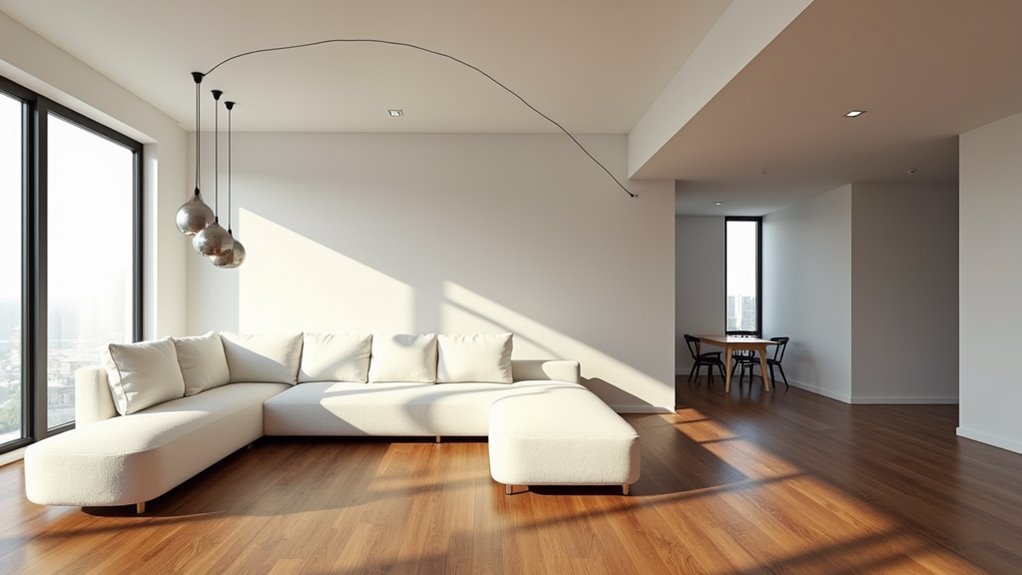
When designing interior spaces, understanding traffic patterns and movement flow becomes essential for creating functional, comfortable environments. You'll want to analyze how people naturally move through your space and arrange furniture to support these pathways.
Consider the daily activities that occur in each room and ensure there's enough clearance between pieces. You can enhance flow by positioning furniture to create clear walkways and avoiding obstacles that interrupt natural movement.
Think about the connections between spaces – how you transition from your entryway to living areas or from your kitchen to dining room. The strategic placement of rugs, lighting, and decorative elements can help guide movement while maintaining open sight lines.
Remember that good flow isn't just about physical movement; it's about creating a sense of visual harmony that makes your space feel intuitive and welcoming.
Multifunctional Furniture Solutions
When you're maximizing your living space, multifunctional furniture becomes your secret weapon for combining style with practicality.
You'll find innovative storage solutions built into ottomans, beds, and coffee tables that eliminate clutter while maintaining aesthetic appeal.
Convertible pieces, like murphy beds and expanding dining tables, help you transform rooms instantly to meet your changing needs throughout the day.
Smart Storage Space Design
As living spaces become increasingly compact, smart storage solutions and multifunctional furniture have emerged as essential elements of modern interior design. You'll find that vertical storage systems, built-in cabinets, and modular units can maximize your space while maintaining aesthetic appeal.
Consider incorporating pull-out drawers under stairs, floating shelves on unused wall space, and ottoman storage beds to utilize every square inch effectively. You can transform awkward corners into functional storage nooks using custom-built solutions or ready-made corner units.
Don't forget about door-mounted organizers and ceiling-mounted racks that make use of often-overlooked spaces.
Convertible Furniture Trends
Modern homes demand more from every piece of furniture, building on the same space-saving principles that guide smart storage design.
Today's convertible furniture combines style with practicality, offering you multiple functions within a single piece. You'll find sofas that transform into beds, coffee tables that rise to become dining surfaces, and ottomans that open up for storage.
As you explore these versatile options, you'll notice innovative mechanisms that make transitions smooth and effortless.
Murphy beds now feature built-in desks, while modular seating systems adapt to your changing needs.
The latest trends include wall-mounted tables that fold away when not in use, stackable chairs that double as shelving units, and expandable consoles that can seat up to twelve dinner guests.
Space-Saving Living Solutions
Since urban living spaces continue to shrink, maximizing every square foot has become essential for comfortable living. You'll find countless ways to make your space work harder through innovative storage and multifunctional solutions.
Consider installing floor-to-ceiling shelving units that double as room dividers, or investing in ottomans with hidden storage compartments.
Transform your living area with murphy beds that fold into the wall, revealing a desk or sofa during the day. You can also utilize vertical space with hanging organizers, magnetic strips for kitchen tools, and wall-mounted tables that fold down when needed.
Don't overlook the potential of under-bed storage, stackable containers, and multi-purpose kitchen islands that serve as dining tables and workspace. These solutions help you maintain a clutter-free, efficient living environment.
Lighting's Impact on Wellbeing
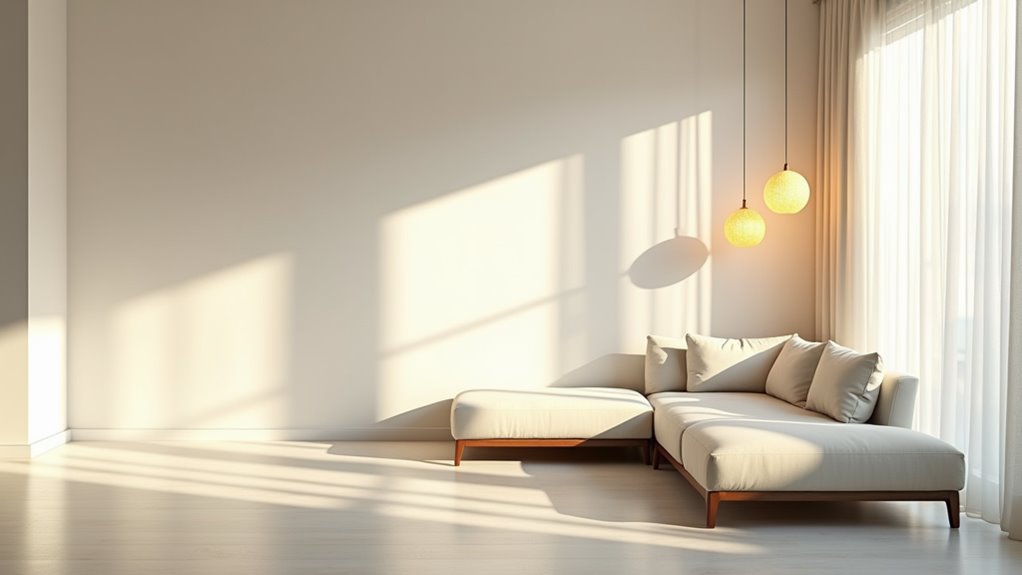
While natural and artificial lighting may seem like simple environmental factors, they profoundly influence your physical and mental wellbeing. From regulating your circadian rhythm to affecting your mood and productivity, lighting plays a crucial role in how you experience your living space.
You'll notice immediate benefits when you maximize natural light through strategic window treatments and reflective surfaces. Position your desk or reading nook near windows to harness daylight, and consider installing dimmer switches to adjust artificial lighting throughout the day.
Cool, bright lights can energize your morning routine, while warm, soft lighting helps you unwind in the evening. For optimal results, layer your lighting with a mix of ambient, task, and accent fixtures to create a flexible environment that supports your daily activities and emotional needs.
Technology Integration in Spaces
Today's homes seamlessly blend technology with everyday living, transforming how you interact with your space. From smart lighting systems that adjust to your circadian rhythm to voice-activated appliances that simplify daily tasks, technology enhances both functionality and comfort.
You'll find that strategic placement of charging stations and wireless capabilities can eliminate unsightly cords while maintaining connectivity. Consider incorporating hidden screens that emerge from furniture, automated window treatments that respond to sunlight, and climate control systems you can adjust from your phone.
When integrating technology, focus on solutions that truly serve your lifestyle rather than adding gadgets for novelty. The key is creating a space where technology supports your daily activities without dominating the aesthetic or compromising your home's warmth and personality.
Frequently Asked Questions
How Much Does It Typically Cost to Hire an Interior Designer?
You'll typically spend between $50 to $200 per hour for an interior designer's services, or 10-30% of your total project cost.
For smaller projects, you can expect to pay $2,000 to $5,000, while full-house designs can range from $10,000 to $50,000.
Many designers also offer flat-rate packages, and some retail stores provide basic design services for free with furniture purchases.
Can Interior Design Improve the Resale Value of My Home?
Picture walking into a beautifully staged home where every detail feels intentional and inviting.
That's what strategic interior design can do for your property's value.
You'll typically see a 5-15% increase in your home's selling price with professional interior design, especially when focusing on key areas like kitchens and bathrooms.
It's not just about aesthetics – you're creating an emotional connection that makes buyers willing to pay more.
What Interior Design Certifications and Qualifications Should I Look For?
Look for designers with NCIDQ (National Council for Interior Design Qualification) certification, which is the industry's highest standard.
You'll also want to check for ASID (American Society of Interior Designers) or IIDA (International Interior Design Association) membership.
A bachelor's degree in interior design is valuable, and additional certifications in sustainable design (LEED) or kitchen and bath design (NKBA) can indicate specialized expertise.
How Long Does a Complete Interior Design Project Usually Take?
The timeline for your interior design project can vary significantly based on its scope.
A single room refresh might take 2-4 weeks, while a full home renovation could span 3-6 months or longer.
You'll need to factor in planning, design development, ordering materials, and installation.
Custom furniture pieces typically add 8-12 weeks, and contractor availability can impact your timeline substantially.
Should I Follow Current Design Trends or Stick With Timeless Elements?
"Beauty is in the eye of the beholder," and that's especially true with interior design.
You'll want to strike a balance between trends and timeless elements.
Consider incorporating 80% classic, enduring pieces for your foundation while allowing 20% trendy accents that you can easily update.
This way, you won't feel pressured to completely renovate when trends change, and you'll maintain a space that feels both current and lasting.
Conclusion
Your living space, like a carefully composed symphony, should harmonize with your lifestyle while nurturing your wellbeing. By implementing thoughtful design principles – from color psychology and sustainable practices to smart technology integration – you'll transform your home into a sanctuary that supports your daily needs. When you embrace these interior design elements, you're not just decorating; you're crafting an environment that enhances every aspect of your life.
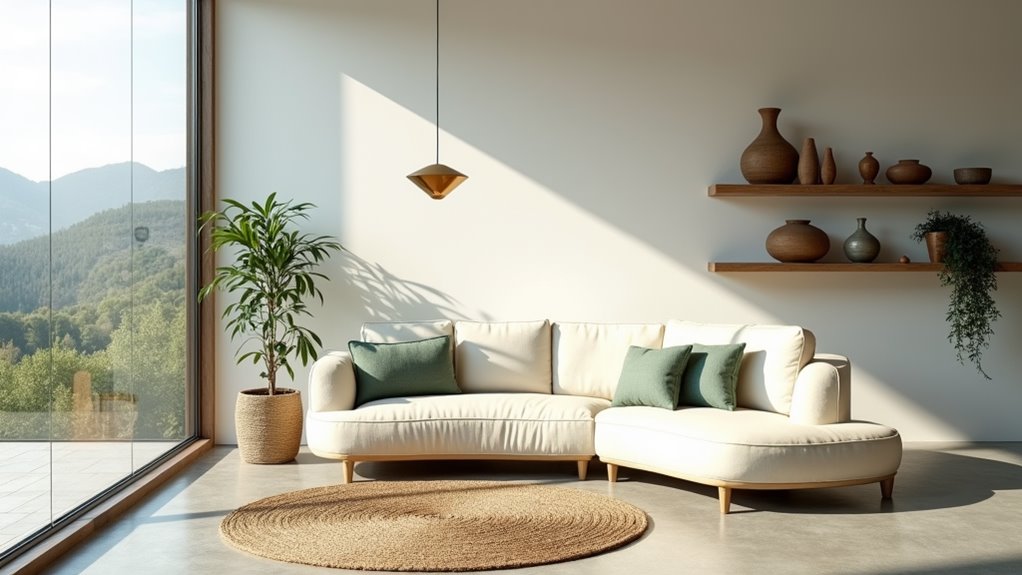
Leave a Reply